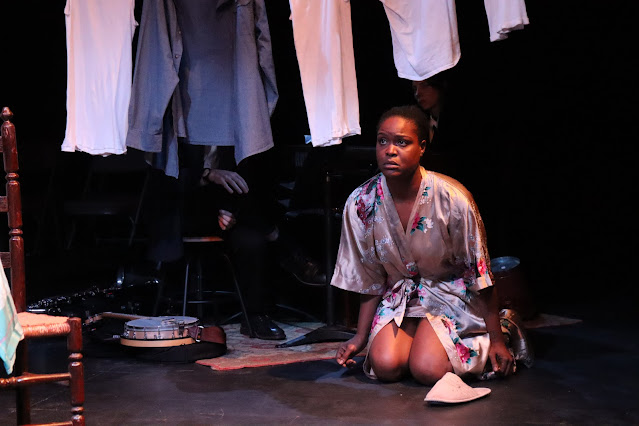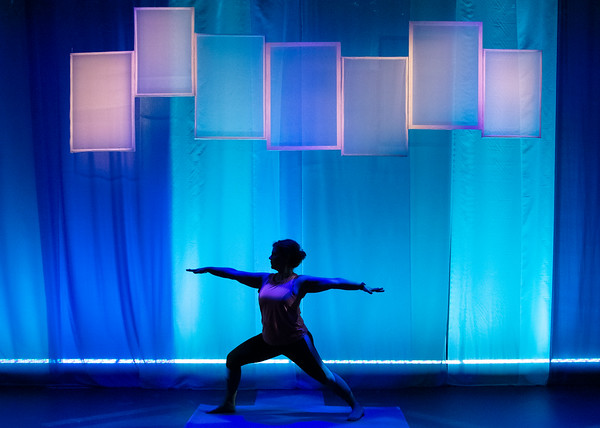Falling Sideways Off the Edge of the Earth
Written by Pamela Enz
Directed by C.C. Kellogg and Avery Wigglesworth
155 1st Ave., Manhattan, NYC
January 13-28, 2024
 |
Ginna Hoben and Marlon Xavier. Photo by Christian Frederick Stevenson
|
Some plays are content to render the "big" metaphysical questions as subtext.
Falling Sideways Off the Edge of the Earth is not one of those plays. From playwright Pamela Enz, who has described herself as a "hybrid theatrical collagist,"
Falling Sideways Off the Edge of the Earth comes at the big questions straight on and from multiple angles, foregrounding interrogations of sexuality, death, religion, the natures of humanity and the universe, and more in a poetic tissue of voices and viewpoints dense with both ontological inquiry and memorably crafted lines. This production demands the audience's attention from its opening moments, drawing spectators inexorably into and through the swirling liminality which it creates for its characters.
 |
| Ana Semedo. Photo by Christian Frederick Stevenson |
Before the lights come up, we hear a heartbeat, a sound that raises various primal associations in the darkness and which continues through much of the play, contributing its constant rhythm (and thematic intersections) to the unique atmosphere which the production establishes. The heartbeat is soon joined by the surprisingly delicate strains of a theremin (played live by Karen Cecilia, who also plays the Vagabond Mystic) and a collage of projected images, including of cell division and a heart, that will also continue, in modulating, rapid sequences, throughout the play before, at the significant points that the heartbeat stops, resolving into an image of a baggage carousel, echoing other circularities within the piece. At the center of the play is Marnie (Ginna Hoben, in an amazing performance, the lodestar of the production), who finds herself and her (literal) baggage in a strange sort of non-place–evoked by set designer Ève Laroche-Joubert, a longtime Enz collaborator through a ladder, a large moveable frame like a glassless standing mirror, and an even larger see-saw platform–and unsure if she is alive or dead, though she is pretty sure she feels alive. That question is complicated by the appearance of Robert (Marlon Xavier), whom she is much more sure is already dead.
 |
| Ginna Hoben and Violet Savage. Photo by Christian Frederick Stevenson |
Amongst discussion of everything from Robert's sexual behavior(s) to whether Marnie standing naked in a window constituted a prayer, the play divulges fragments of (their) lives and deaths, including by violence and accident, some that can be pieced together (although assembling some definitive linear narrative is in no way the point here) and some that discretely add to the production's larger tapestry. The relationship between sexuality and religion forms an important strand in the play's thought–in fact, before we meet Robert, and even just before we meet Marnie, we have already encountered the Virgin Bride (Ana Semedo), a model of religious rectitude (except for moments when she represents liberation from that mode of being). Marnie takes an overwhelmingly critical stance vis-à-vis religion's prohibition of (especially women's) pleasure (and by extension agency) and its weaponization of guilt and shame. Providing another contrapuntal voice is the Vagabond Mystic, who sees no boundary between the scientific–particle physics, to take one example–and the transcendental. Periodically, too, The Voice from Beyond (Bobe Jaffe) emanates from an antique radio, sharing news of death, near death, and post-death experiences, most amusingly odd (such as a corpse being the victim of a shooting while in its own coffin) but some nakedly tragic. And we haven't even yet mentioned Annie, daughter to Marnie, played with equal aplomb in both her college-age and younger, puppet versions by Violet Savage.
 |
| L to R: Marlon Xavier, Violet Savage, Karen Cecilia, Ana Semedo, and Ginna Hoben. Photo by Christian Frederick Stevenson |
That there is much we haven't even touched on to this point, not least regarding the stories of Annie, Robert, and Marnie, testifies to the engaging depth of this play. The striking uses of physicality and movement by the cast, fitting for the show's concern with embodiment and existence, deserve mention as well. Late in the production, Annie and the images of the screen behind her return us to the play's beginning, creating a circle (after all, even the universe itself may endlessly cycle through its own creation and destruction) but then moving beyond that closed loop and shifting to rather more directly stating a thesis–and to looking explicitly toward humanity's future. Falling Sideways Off the Edge of the Earth leaves us with the well-taken admonition to foster impulse and irregularity, what humanity has that algorithms never can have–emotion of any kind is not some abstract calculation but inextricable from the body and its biology–as well as "being without purpose other than the next breath." One form of being without purpose is of course captured in the word "play," and Falling Sideways Off the Edge of the Earth creates a richly compelling space of play that exemplifies its own recommendations.
-John R. Ziegler and Leah Richards







Comments
Post a Comment